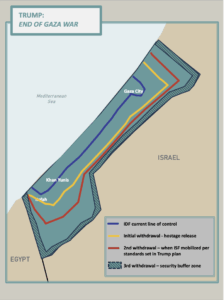Netanyahu Made Major Changes to Trump’s Gaza Plan, Infuriating Arab Leaders: Report

Washington (QNN)- Israeli Prime Minister Benjamin Netanyahu has reportedly made significant changes to the Gaza plan presented by President Trump on Monday, angering Arab officials involved in the negotiations.
Axios reported on Tuesday, citing sources familiar with the process, that Israel, the US and its Arab partners were all aligned on a final plan.
While Trump and Netanyahu were discussing the plan on camera at the White House, Qatari Prime Minister Mohammed bin Abdulrahman al-Thani was presenting it to Hamas leaders in Doha, a source with knowledge said.
The deal now before Hamas is significantly different from the one the US and a group of Arab and Muslim countries had previously agreed on, due to Netanyahu’s intervention.
On Sunday, White House envoy Steve Witkoff and Trump’s son-in-law Jared Kushner met for six hours with Netanyahu and his confidant Ron Dermer.
Netanyahu managed to negotiate several edits into the text, in particular on the conditions and timetable for Israel’s withdrawal from Gaza.
The new proposal ties Israel’s withdrawal to the progress of disarming Hamas, and gives Israel a veto over the process, Axios reported.
Even if all conditions are met and three phases of withdrawal are completed, Israeli forces will still remain within a security perimeter inside Gaza “until Gaza is properly secure from any resurgent terror threat.” That could mean indefinitely.
According to Axios, officials from Saudi Arabia, Egypt, Jordan and Turkey were furious over the changes.
The Qataris even tried to convince the Trump administration not to release the detailed plan on Monday due to those objections. The White House released it anyway, and pushed the Arab and Muslim countries to support the plan.
What We Know?
Netanyahu stated that the military will “remain in most of the Gaza Strip,” contradicting the Trump-proposed plan.
“We will recover all our hostages, alive and well, while the [Israeli military] will remain in most of the Gaza Strip,” said Netanyahu in a video shared earlier on Tuesday morning during which he also added that the plan has “turned the tables and isolated Hamas” with terms favourable to Israel.
However, his statement appears to contradict the details of the Trump plan, which stipulates that “Israel will not occupy or annex Gaza” and that its military will gradually withdraw until fully pulled out, except for a temporary security-perimeter presence.
Point 3 of what was then a 21-point plan reported by The Times of Israel stated that “Israeli forces will withdraw to the battle lines as of when the [US special envoy Steve] Witkoff proposal was presented to prepare for hostage release.”
It didn’t specify which Witkoff proposal, even though there have been several. But the updated version published on Monday by the White House stated that “Israeli forces will withdraw to the agreed-upon line.”
It reportedly appeared to refer to a new map that was included in the updated version that illustrated three phases of Israeli withdrawals from Gaza.
As Netanyahu mentions in his video, the map shows that Israeli troops will be able to remain in the majority of the Gaza Strip even after the first pullback of Israeli forces in preparation for all of the captives to be released.
They will then be able to remain in those positions until the International Stabilization Force (ISF) of Arab and Muslim countries is prepared to deploy, the plan states.
Even after the second phase of the withdrawal, the forces will remain in over a third of the Strip, the map indicates.
The third withdrawal will clear the final forces out of Gaza, but the map shows that a security buffer zone will be established along the perimeter of the entire Strip.
Point 16 of the original US plan stated that the forces “will progressively hand over the Gaza territory that [it] occup[ies].”
But the updated version adds two lines that further qualify the nature of the withdrawal in Israel’s favor, stating that the forces “will withdraw based on standards, milestones, and timeframes linked to demilitarization that will be agreed upon between the IDF, ISF, the guarantors, and the US.”
“Practically, the IDF will progressively hand over the Gaza territory it occupies to the ISF according to an agreement they will make with the transitional authority until they are withdrawn completely from Gaza, save for a security perimeter presence that will remain until Gaza is properly secure from any resurgent terror threat,” the updated plan adds.

Hamas has affirmed its “readiness to positively and responsibly consider any proposals received from the mediators, in a way that safeguards the national rights of our people,” including ending the ongoing genocide.
Qatar and Egypt handed the proposal to Hamas on Monday, and “the group’s negotiating delegation promised to study it responsibly,” foreign ministry spokesman Majed al-Ansari told a press conference.
Opposition leader Yair Lapid said afterwards: “Netanyahu says ‘yes’ when he’s in front of the cameras in Washington, then says ‘but’ when he returns and insists that this should not happen now.”
The 20-point plan also says: “While Gaza re-development advances and when the PA reform program is faithfully carried out, the conditions may finally be in place for a credible pathway to Palestinian self-determination and statehood, which we recognise as the aspiration of the Palestinian people.”
However, Netanyahu also insisted the plan does not mean Palestinian statehood, and that Israel will “forcibly resist” the idea




